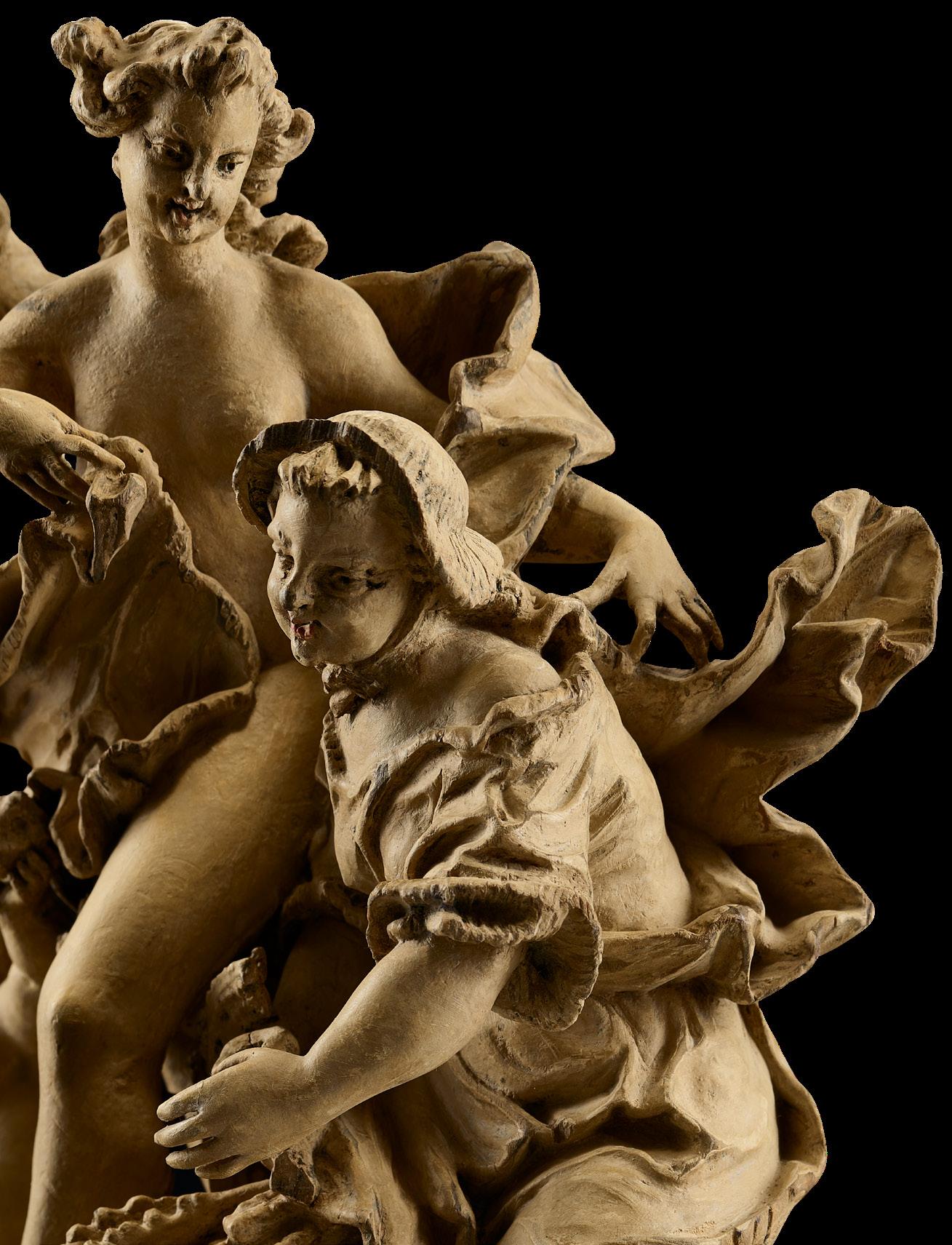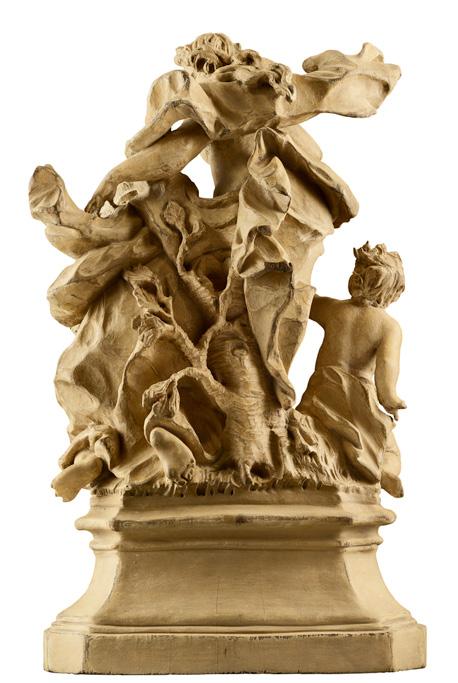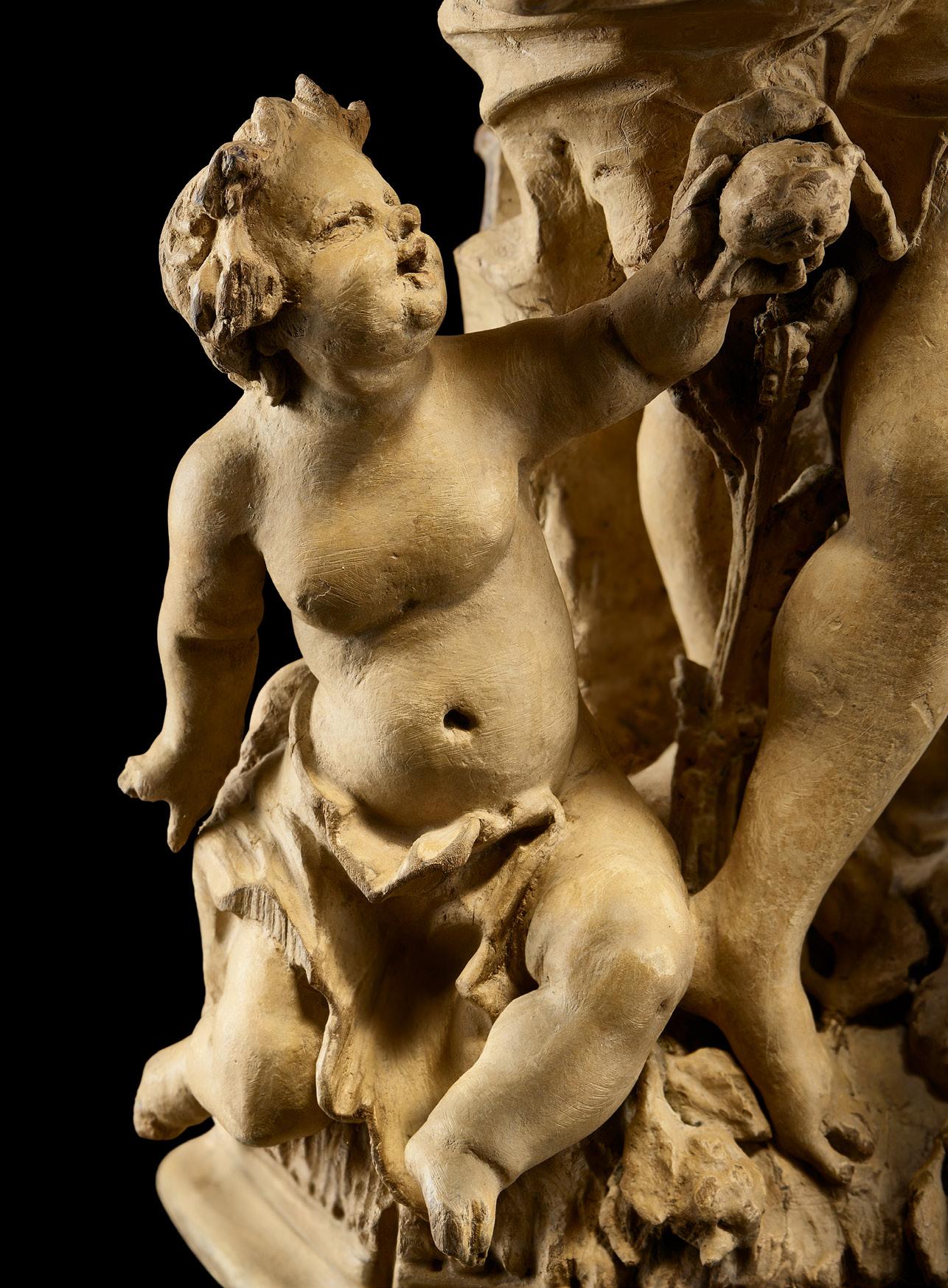
4 minute read
25 Ceres, Allegory of Summer, by Ferdinand Tietz
Ceres, Allegory of Summer, by Ferdinand Tietz
25
Advertisement


Ceres, Allegory of Summer by Ferdinand Tietz
Ferdinand Tietz
Holešice, Bohemia 1708 – 1777 Seehof near Bamberg, Germany
Circa 1760 Bozzetto, linden wood with the original polychromy to imitate sandstone Height: 30 cm
Related Literature: Lindemann, Bernd Wolfgang. Ferdinand Tietz 1708 – 1777, Weißenhorn 1989, cf. fig. 14 (Allegory of Summer), 109 (Pan), 342 (Mercury)
Trenschel, Hans-Peter. Die Bozzetti-Sammlung – Kleinbildwerke des 18. Jahrhunderts im Mainfränkischen Museum Würzburg, Würzburg 1987 Not far from Bamberg is the former summer residence of the prince-bishops, the beautiful palace known as Schloss Seehof. It is an impressive testimony to the once so impressive court upheld by the bishopric and, at the same time, it is the artistic legacy of one of the greatest Rococo artists of southern Germany, Ferdinand Tietz, who originally came from Bohemia.
Born in Holešice, probably in 1708, as Ferdinand Dietz, he later changed the spelling of his surname to ‘Tietz’. He came from a family of craftsmen; his father was a sculptor and had a workshop in Jezeří. Although Ferdinand was later to become a successful sculptor there is no documentary evidence covering the first third of the artist’s lifetime. He most probably went to Vienna where he met the sculptor Johann Wolfgang von der Auwera (1708 – 1756), as stylistic parallels reveal. Is is not until 1736, when he was twenty-eight years old, that the artist is mentioned in archival records. He worked under Balthasar Neumann (1687 – 1753) on large projects in the Würzburg Residenz, as shown on various invoices. In 1747 Tietz was summoned to Bamberg by Prince-Bishop Johann Philipp Anton von Franckenstein (1695 – 1753) who commissioned him to devise a comprehensive plan of figures for the park at Schloss Seehof. This project represents the highlight of the park’s overall design and Tietz’s artistic breakthrough. Together with his workshop, Tietz – who was appointed court sculptor in 1748 – completed some 400 masterly worked and powerfully modelled sculptures of playfully exuberant figures captured in motion. They were to make the artist famous well beyond the region.1
25


In 1754 Tietz was called to Trier by the prince-bishop Franz Georg von Schönborn (1682 – 1756) and did not return to Bamberg until 1760 where, in the meantime, Adam Friedrich von Seinsheim (1708 – 1779), Prince-Bishop of Würzburg, had taken over the prince-bishopric office in Bamberg as well, as the position had become vacant.
In 1765 Seinsheim commissioned Tietz to submit new designs for the court garden at Veitshöchheim near Würzburg. To accompany the architectural plans he devised a comprehensive sculptural agenda. The court sculptor made a major contribution to peopling the garden with allegorical stone figures from mythology between 1765 and 1768. Upon completion in 1776, some 300 figures decorated the garden, of which some 200 have survived. They were originally painted à la porcelaine2 that would certainly have made an impressive sight. In 1767 Ferdinand Tietz was also appointed court sculptor in Würzburg. However, after completing his commissions for Würzburg and Bamberg he did not receive any further work of note. His playful style reflecting the zeitgeist of the Rococo period was no longer in keeping with the increasingly sobre and seemingly harsh lines of emerging art tastes. Tietz died in 1777 at the age of 69 in Seehof near Bamberg.
Our figurative group is a so-called bozzetto, a small sculptural work made of lindenwood used as a model that would have been presented to the patron who gave the commission, presumably Adam Friedrich von Seinsheim, before work started on the large sculpture in stone.
Front and back side
A youthful-looking, nude woman is depicted in a dynamic pose standing on an octagonal pedestal with sweeping concave curves and a central floral relief. A small putto and woman in peasant’s garb kneeling at her feet proffering a sheaf of grain, form her entourage. The ripe corn is an attribute of the Roman goddess Ceres and reveals the sensual beauty as an allegory of summer.
The bozzetto was the model for a garden figure and was most pro-bably once painted.3 It is similar to an allegory of summer that Tietz made in 1765/67 for the court garden at Veitshöchheim in which the motif of the kneeling peasant woman with a gift of grain also appears. The small putto, however, is not included and the goddess is clothed. The virtuosity and dynamism of the small sculpted work are lacking; instead the garden figure exudes a calm majesty. In the case of the garden figure Tietz also eschewed the sensually erotic aesthetic and gleeful exuberance that characterise the bozzetto, presumably at the request of the patron. The bozzetto serves to explain the work’s formal artistic language.
Due to the work’s high artistic quality and taking stylistic comparisons into consideration we assume that this bozzetto is a work by Ferdinand Tietz himself. In all probability, the Ceres group served as a model for the Allegory of Summer in the garden at Veitshöchheim.
Pan, Bamberg, 1760/61, showing the figure in 1968; today, only the torso has survived. Private collection B. W. Lindemann, Ferdinand Tietz, fig. 109, p. 109
3 Hans-Peter Trenschel, the former director of the Mainfränkisches Museum in Würzburg emphasises that, in Tietz’s case, sketches did not play a role in the creative process of a sculpture. Instead, he generally carved small wooden figures immediately before, in preparation for his work on the stone figures (F. Tietz Symposium, Bamberg, 2008). 25








